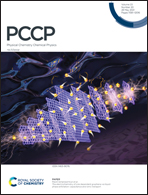Copper (Cu2+) ion-induced misfolding of tau protein R3 peptide revealed by enhanced molecular dynamics simulation†
Abstract
Tau misfolding plays a significant role in some neurodegenerative diseases such as Alzheimer's disease (AD). It is intrinsically disordered and highly soluble under normal physiological conditions. While the protein will aggregate to form paired helical filaments (PHFs) under copper homeostasis at pathological conditions, which is the main substance of neurofibrillary tangles (NFTs) in the brain of AD patients. However, the molecular mechanism underlying the copper (Cu2+) ion-induced tau misfolding is not fully understood. In this study, using the 1/2 third repeat fragment (R3 peptide) of tau protein (residues 318–335: VTSKCGSLGNIHHKPGGG) as a model, a Gaussian accelerated molecular dynamics (GaMD) method followed by efficient trajectory analysis was carried out to investigate the influences of Cu2+ on the tau about the protein fold and the free energy landscape along the simulation. The two-dimensional potential of mean force (PMF) profiles obtained from reweighting of the GaMD simulations as well as clustering analysis revealed the Cu2+ ion induced α-helix fold R3 peptide located at the low-energy wells of free energy map, which is in agreement with the reported experimental result. In contrast, there is no α-helix fold of R3 peptide that appeared during the GaMD simulation without Cu2+ ion existing. Furthermore, the definition of secondary structure of protein (DSSP) analysis indicated that the R3 peptide with Cu2+ ion forms a stable structure of the helix (Lys321–His330 interval of the peptide) at between 400 and 500 ns. Therefore, the structures and free energy profiles from GaMD simulations proposed that Cu2+ triggers the aggregation of R3 peptide into toxic PHFs through a stable α-helix fold form.



 Please wait while we load your content...
Please wait while we load your content...